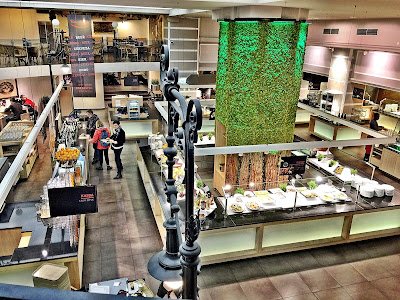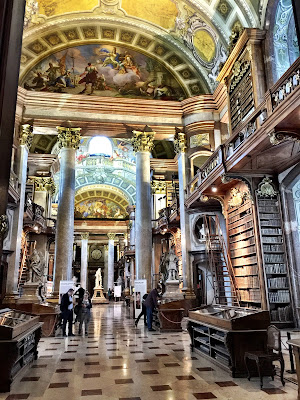Today’s itinerary for our stay in Vienna is to visit the Schönbrunn Palace, and the Hofburg - the imperial compound. The Schönbrunn Palace is on the outskirt of Vienna and it was a short drive from our hotel by our tour bus.
Our hotel is located next to the Vienna Ring Road. The road used to be a city wall. The wall was demolished in the min-19th century to make way for a major circular thoroughfare. Major grand buildings in Neo-Gothic, Neo-Renaissance, Neoclassical, and Neo-Baroque styles were constructed along this road.
On our way to Schönbrunn Palace, we went through a small section of the beautiful Ring Road.
(Click on each picture to get the full-size view)


We also drove past the Secession Building. The Art Nouveau style exhibition hall was built in the late-19th century for the Vienna Secession movement, which rebelled against the then established fine art institution.
The front view of the Schönbrunn Palace. The palace served as the imperial summer residence for the Habsburg monarchy before the empire collapsed after WWI. The palace, along with its garden, is designated as a UNESCO World Heritage Site.

The Neoclassical palace sits on an expansive ground. The building and the garden are grand and impressive. The palace building is now a museum and does not allow photo taking inside.

Behind the palace is a huge and well-layout garden.

At the far end of the garden is the Gloriette on the hill (under shroud for repair), and the Neptune Fountain at the foothill.

View from the viewing platform at the back of the palace.

The Neptune Fountain at the far end of the garden.

Back view of the palace and the garden.

After the Schönbrunn Palace, our next stop was Hofburg, the imperial compound. The powerful Habsburg monarchy once ruled a major portion of Europe for over 600 years until the end of WWI in 1918. Over many generations of the long-lasting dynasty, the empire’s capital Vienna was built into a cultural, economic, and political center. The Hofburg imperial compound is located in the city center of Vienna, which is designated as a UNESCO World Heritage Site.
We passed by the Vienna State Opera again. The opera house sits in the very center of the city. It is also in the middle of a major thoroughfare of the city. We would pass by this location several times during our stay in Vienna.


We drove by an imperial garden. The statue of Mozart is a popular tourist attraction.

Our first stop in the imperial compound is the Maria-Theresien-Platz (Maria-Theresa Square). In the center of the vast square is a very imposing statue of Empress Maria-Theresa, the matriarch of the Habsburg Empire.

Flanking the statue on both sides of the plaza are two equally impressive museums. Both are built exactly the same except the decorating sculptures adorning the buildings.
This one is the Naturhistorisches Museum (Natural History Museum) with Maria-Theresa Memorial on the left.

Directly on the other side of the plaza, also facing the Maria-Theresa Memorial, is the Kunsthistorisches Museum (Art History Museum).

From Maria-Theresa Square, we walked across the Ring Road and entered the Hofburg proper.
The first palace is the Neue Burg (New Palace) with a magnificent semi-circular frontage.

In front of the Neue Burg is the Heldenplatz (Hero’s Square) with the statue of Prince Eugene in the center.

From Neue Burg, through a passageway, we entered the Imperial Chancellery and Apartment.
It requires an admission ticket to tour the inside of this palace. Our group didn’t take the tour.

The rooftop of the Imperial Chancellery.


This part of the Imperial Apartment is called Alte Burg (Old Palace). The status of Emperor Franz I sits in the courtyard.

This sculpture-adorned passageway on one side of the Alte Burg leads to a rotunda.

This rotunda serves as the entryway into the imperial apartments.

Outside the rotunda is the splendid Saint Michale Wing and Arch. This is the formal entrance into the Hofburg, the imperial compound.


On a walkway along the perimeter of the Hofburg, we passed by the Stallburg, the imperial stable for the Spanish riding school.

Further down from the Stallburg on the perimeter of the Hofburg is the Austrian National Library.

In front of the library is the statue of Joseph II, Maria-Theresa's eldest son.
Our guided tour ended after the tour of Hofburg. We then joined a Gate-1 optional tour to see the Imperial Treasury. The extensive collection of the imperial treasures are housed in a section of Hofburg. The rare treasures were compiled by the Imperial House of Habsburg over the course of many centuries.
This picture shows Imperial Crown, Orb, and Sceptre of Austria - the insignia of the Austrian Empire.
Imperial Mantle Robe for the occasion of coronation.
Imperial Crown from 1605.
Imperial Crown of the Holy Roman Empire from 960.
There are many treasures on display in the Imperial Treasury. They are as impressive, if not more, as the royal treasures at the Tower of London.
Our optional tour was also going to take us inside the Vienna State Opera. But because the opera house had a rehearsal in progress in the afternoon, we were detoured to see the Imperial Crypt.
I wasn’t interested in seeing coffins so no picture was taken.
After the crypt tour, we walked by this small alley, which leads to the back of a church where the renowned Vienna Boys’ Choir practices and performs.
After our optional tour finished, our tour guide suggested a place for lunch. This cafeteria has just been remodeled so it looked clean, and food selections were plentiful.
https://www.yelp.com/biz_photos/rosenberger-marktrestaurant-wien
The rest of the day we were on our own. We decided to just go with the flow and randomly followed many of the other tourists on the street.
I don’t know why there was a rabbit on a street corner. My wife and I are both rabbits according to the Chinese zodiac so we took this picture of our own species.
We soon were passing by the opera house again.
The Neoclassical building with a black marble slate protruding from the rooftop is Albertina Museum. The building was once a palace for an Austrian prince. Now it houses a sizable collection of graphic art and drawings.
We followed a throng of tourists to this entrance to Burggarten, the Hofburg palace garden.
On one side of the garden is the Imperial Butterfly House, an Art Nouveau greenhouse with the butterfly inside.
At the top of the garden is this marvelous and imposing palace. It turns out to be the backside of the Neue Burg (New Palace) we saw earlier.
This building is really majestic and beautiful. The ornate details of the exterior are amazing.

Going around the Neue Burg we found ourselves walking on the Ring Road. A short distance later we were back at the Maria-Theresa Square.
And again at the front of one of the History Museums.
And again in front of the Neue Burg. The New Palace now houses three museums and a reading room for the National Library. We asked to use the restroom and was directed by the reading room staff to go to the main National Library.
A short walk later we found the restroom at the main library. Unexpectedly we also found this opulent reading room in the main library. The library is the largest Baroque library in Europe. It requires an admission ticket to get in so we only took the picture at the reading room entrance.
We were also back at Saint Michale Wing and Arch, the formal entrance into the Hofburg.
Outside the Hofburg is an exclusive shopping area of Vienna

Vienna is full of tourists and it feels very safe. A friendly tourist wanted to be a photobomb for my selfie.
On our way to St. Stephen's Cathedral we got lost. We nonetheless saw a strikingly beautiful passageway, called Freyung Passage. Once inside we found fancy shops, marble columns, decorative friezes, intricate ornaments, and an exquisite courtyard.

We asked a local for direction and got re-oriented toward St. Stephan Cathedral, our destination.
On the way, we passed by another church, St. Peter's Church, with an interior in rich Baroque style
The glorious St. Stephen's Cathedral.



It was 10 minutes’ walk from St Stephen’s Cathedral back to our hotel. The city park next to our hotel also has many attractions. This Franz Schubert statue in the city park is not too far from our hotel.
So is this gilded bronze Johann Strauss Monument.
Vienna is a wonderful city. I enjoyed the city very much. Its magnificent palaces, the rich history, the cleanness of the city, and the friendliness of locals are all appreciated. There are many more places in the city I have yet to visit. I look forward to coming back for more visits again.
A wonderful city with high culture and class.
Vienna is blessed with magnificent relics from a regal past.
A place worth many repeated visits and excitements hard to surpass.
My fond memory of the city will forever last.
-Joe































No comments:
Post a Comment